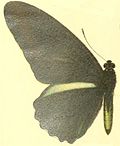| Crassus swallowtail | |
|---|---|
 | |
| Mounted specimen on display at Museo di Scienze Naturali Enrico Caffi, Bergamo | |
| Scientific classification | |
| Kingdom: | Animalia |
| Phylum: | Arthropoda |
| Class: | Insecta |
| Order: | Lepidoptera |
| Family: | Papilionidae |
| Genus: | Battus |
| Species: | B. crassus |
| Binomial name | |
| Battus crassus (Cramer, 1777) | |
| Synonyms | |
| |
Battus crassus, the Crassus swallowtail, is a species of butterfly from the family Papilionidae.
Contents
